Estimation of ABO hemolytic disease of the fetus and newborn through gene frequency study and immunohematological characterization of the disease
IF 1.4
4区 医学
Q4 HEMATOLOGY
引用次数: 0
Abstract
Introduction
The ABO-hemolytic disease of the fetus and newborn (HDFN) occurs when a blood group “O” mother carries a non-blood group “O” fetus. Seldom hyperbilirubinemia may occur, requiring treatment. We calculated the prevalence of ABO-HDN in our population and addressed the immunohematological tests required for its characterization.
Methodology
The frequency of ABO genes was arithmetically derived from the phenotype data. The probability of non-blood group “O” children born to blood group “O” mothers was estimated. Immunohematological investigations were performed and clinical and laboratory outcomes of each newborn were observed till discharge from hospital.
Results
A total of 913 group “O” mothers gave birth to non-group “O” children which resulted in 20 (2.19 %) cases of HDFN. Direct antiglobulin test (DAT) positivity due to IgG1 or IgG3 or both was observed in 15 (75 %) cases. All newborns received phototherapy and 7 (35 %) in addition required exchange transfusion. The correlation between mother Anti-A and Anti-B IgG titres and newborn DAT was strongly positive. With the increase in newborn DAT strength, the newborn hemoglobin and bilirubin were remarkably deranged. Significant improvements in all laboratory parameters were observed with treatment.
Conclusion
Estimation of gene frequency in a population can predict the probability of group “O” mothers giving birth to non-group “O” children. These calculations along with detailed clinical and laboratory investigations give the number of ABO-HDFN cases in the population. Correlation studies comprising of mother and newborn immunohematological and laboratory factors assess the severity of ABO-HDFN and help in the treatment and follow-up of patients.
通过基因频率研究和免疫血液学特征描述估算胎儿和新生儿 ABO 溶血病的发病率
胎儿和新生儿abo -溶血性疾病(hddn)发生在O型血母亲携带非O型血胎儿的情况下。很少发生高胆红素血症,需要治疗。我们计算了ABO-HDN在我们人群中的患病率,并解决了其特征所需的免疫血液学测试。方法ABO基因的频率由表型数据计算得出。估计了O型血母亲所生非O型血儿童的概率。对每个新生儿进行免疫血液学检查,并观察临床和实验室结果,直至出院。结果913例“O”族母亲生育的非“O”族儿童中有20例(2.19 %)发生HDFN。直接抗球蛋白试验(DAT)阳性15例(75% %),IgG1或IgG3或两者均阳性。所有新生儿均接受光疗,另有7例(35% %)需要换血。母亲抗- a和抗- b IgG滴度与新生儿DAT呈显著正相关。随着新生儿DAT强度的增加,新生儿血红蛋白和胆红素明显紊乱。治疗后所有实验室参数均有显著改善。结论通过对群体基因频率的估计,可以预测“O”族母亲生育非“O”族子女的概率。这些计算加上详细的临床和实验室调查得出人群中abo - hdf病例的数量。包括母亲和新生儿免疫血液学和实验室因素的相关研究评估abo - hdn的严重程度,并有助于患者的治疗和随访。
本文章由计算机程序翻译,如有差异,请以英文原文为准。
求助全文
约1分钟内获得全文
求助全文
来源期刊
CiteScore
3.60
自引率
5.30%
发文量
181
审稿时长
42 days
期刊介绍:
Transfusion and Apheresis Science brings comprehensive and up-to-date information to physicians and health care professionals involved in the rapidly changing fields of transfusion medicine, hemostasis and apheresis. The journal presents original articles relating to scientific and clinical studies in the areas of immunohematology, transfusion practice, bleeding and thrombotic disorders and both therapeutic and donor apheresis including hematopoietic stem cells. Topics covered include the collection and processing of blood, compatibility testing and guidelines for the use of blood products, as well as screening for and transmission of blood-borne diseases. All areas of apheresis - therapeutic and collection - are also addressed. We would like to specifically encourage allied health professionals in this area to submit manuscripts that relate to improved patient and donor care, technical aspects and educational issues.
Transfusion and Apheresis Science features a "Theme" section which includes, in each issue, a group of papers designed to review a specific topic of current importance in transfusion and hemostasis for the discussion of topical issues specific to apheresis and focuses on the operators'' viewpoint. Another section is "What''s Happening" which provides informal reporting of activities in the field. In addition, brief case reports and Letters to the Editor, as well as reviews of meetings and events of general interest, and a listing of recent patents make the journal a complete source of information for practitioners of transfusion, hemostasis and apheresis science. Immediate dissemination of important information is ensured by the commitment of Transfusion and Apheresis Science to rapid publication of both symposia and submitted papers.

 求助内容:
求助内容: 应助结果提醒方式:
应助结果提醒方式:


